
The Avenue Hoche is an avenue in the 8th arrondissement of Paris, France.

The Avenue Hoche is an avenue in the 8th arrondissement of Paris, France.
The avenue runs the intersection at 67, Rue de Courcelles and the Place du Général-Brocard all the way to the Place Charles de Gaulle and its Arc de Triomphe, in the 8th arrondissement of Paris.
Originally named the Boulevard de Monceau, the Avenue Hoche was first opened in 1854 between the Rue de Tilsitt and the Place de l'Etoile. Three years later, it was extended from the Rue de Tilsitt to the Rue de Courcelles. It was later renamed in honour of General Lazare Hoche. [1]
French royalist and general Athanase-Charles-Marie Charette de la Contrie lived there after the royal family was removed from the Palace of Versailles.

The Place Charles de Gaulle, historically known as the Place de l'Étoile, is a large road junction in Paris, France, the meeting point of twelve straight avenues including the Champs-Élysées. It was renamed in 1970, following the death of President Charles de Gaulle. It is still often referred to by its original name; the nearby Métro and RER station retains the designation Charles de Gaulle–Étoile. Paris's Axe historique cuts through the Arc de Triomphe, which stands at the centre of the Place Charles de Gaulle.
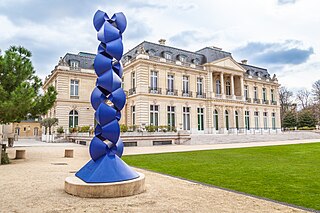
The 16th arrondissement of Paris is the westernmost of the 20 arrondissements of Paris, the capital city of France. Located on the Right Bank, it is adjacent to the 17th and 8th arrondissements to the northeast, as well as to Boulogne-Billancourt, Hauts-de-Seine to the southwest. Opposite the Seine are the 7th and 15th arrondissements.

The 2nd arrondissement of Paris is one of the 20 arrondissements of the capital city of France. In spoken French, this arrondissement is colloquially referred to as deuxième. It is governed locally together with the 1st, 3rd and 4th arrondissement, with which it forms the 1st sector of Paris.
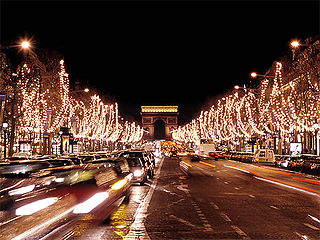
The 8th arrondissement of Paris is one of the 20 arrondissements of the capital city of France. In spoken French, the arrondissement is colloquially referred to as le huitième.
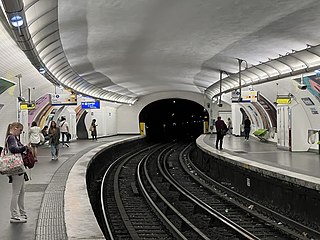
Ternes is a station on Line 2 of the Paris Métro, under the Place des Ternes on the border between the 8th and 17th arrondissements.
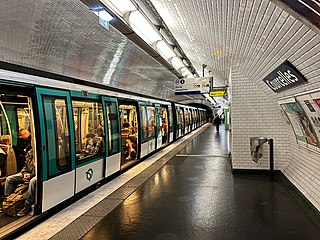
Courcelles is a station on Paris Métro Line 2, under the Boulevard de Courcelles on the border of the 8th and 17th arrondissement of Paris.

Wallace fountains are public drinking fountains named after, financed by and roughly designed by Sir Richard Wallace. The final design and sculpture is by Wallace's friend Charles-Auguste Lebourg. They are large cast-iron sculptures scattered throughout the city of Paris, France, mainly along the most-frequented sidewalks. A great aesthetic success, they are recognized worldwide as one of the symbols of Paris. A Wallace fountain can be seen outside the Wallace Collection in London, the gallery that houses the works of art collected by Sir Richard Wallace and the first four Marquesses of Hertford.

The Wall of the Ferme générale was one of the several city walls of Paris built between the early Middle Ages and the mid 19th century. Built between 1784 and 1791, the 24 km wall crossed the districts of the Place de l'Étoile, Batignolles, Pigalle, Belleville, Nation, the Place d'Italie, Denfert-Rochereau, Montparnasse and the Trocadéro, roughly following the route now traced by line 2 and line 6 of the Paris Métro. The wall was demolished in the early 1860s, although elements of some of its gates remain.

The Place des Pyramides is a public square in the 1st arrondissement of Paris, France. It is located in the middle of the Rue de Rivoli, at its intersection with the Rue des Pyramides and the Avenue du General Lemonnier, at the eastern end of the Tuileries Garden.

The Avenue de Wagram is a street in the 8th and 17th arrondissements of Paris, extending from the Place de Wagram to the Place Charles de Gaulle. It is 1.5 kilometres (0.93 mi) long and 36 metres (118 ft) wide, and is divided into two sections by the Place des Ternes. It was renamed on 2 March 1864 after Napoleon's 1809 victory at the Battle of Wagram; the section between the Avenue des Ternes and the Place de l'Étoile was formerly known as the Boulevard de l'Étoile or Boulevard de Bezons and the section between the Avenue des Ternes and the Place de Wagram, as Route départementale n°6.

The Place des Ternes is a square in the 8th and 17th arrondissements of Paris, at the junction of the Avenue de Wagram, the Boulevard de Courcelles, the Rue du Faubourg-Saint-Honoré and the Avenue des Ternes. It has borne its present name since 1893. In the middle of the square is the Paris Métro Line 2 station Ternes. It is located in the centre of one of the most vibrant communities of the city. The Place de Ternes is surrounded by various markets, parks, landmarks and local shops such as the Marché du Poncelet and Parc Monceau.
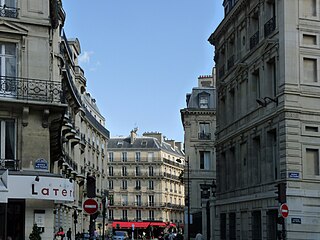
The Rue de Tilsitt is a street in the 8th and 17th arrondissements of Paris. It is one of two streets which form a circle around the Place de l’Étoile - the other is the Rue de Presbourg. It was named after the Peace of Tilsit by a decree of 2 March 1864.
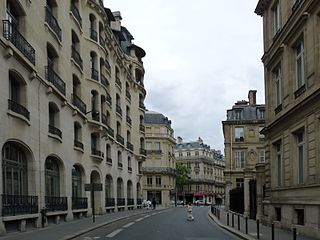
The Rue de Presbourg is a street in the 8th and 16th arrondissements of Paris, France. Since 1864, it has been named after Napoleon's 1805 diplomatic success at the Peace of Pressburg and, with the Rue de Tilsitt, it forms a circle around the Place Charles de Gaulle.

The Rue de Miromesnil is a street in the 8th arrondissement of Paris. It begins at the Rue du Faubourg-Saint-Honoré at the level of the Place Beauvau and ends at the Boulevard de Courcelles.

Errancis Cemetery or Cimetière des Errancis is a former cemetery in the 8th arrondissement of Paris and was one of the cemeteries used to dispose of the corpses of guillotine victims during the French Revolution.
This article presents the main landmarks in the city of Paris within administrative limits, divided by its 20 arrondissements. Landmarks located in the suburbs of Paris, outside of its administrative limits, while within the metropolitan area are not included in this article.

The Boulevard Voltaire is a well-known boulevard in the 11th arrondissement of Paris. It was created by Baron Georges-Eugène Haussmann during the reign of French emperor Napoleon III. Originally named the Boulevard du Prince-Eugène, it was renamed the Boulevard Voltaire on 25 October 1870 in honour of the French Enlightenment writer, historian, and philosopher Voltaire.
The concours de façades de la ville de Paris was an architecture competition organized by the city of Paris at the very end of the 19th century.

The Avenue Marceau is an avenue in Paris, France, marking the boundary between its 8th and 16th arrondissements.

The rue Bleue is a street in the 9th arrondissement of Paris.
48°52′34″N2°18′02″E / 48.8761°N 2.3006°E